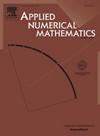一维线性化KdV方程局部不连续Galerkin方法的超收敛性
IF 2.4
2区 数学
Q1 MATHEMATICS, APPLIED
引用次数: 0
摘要
本文利用广义数值通量的局部不连续伽辽金方法,研究一维线性化KdV方程的超收敛性。与传统的迎风通量和交变通量相比,采用广义数值通量的LDG解在长时间模拟中误差增长较慢。通过建立具有适当数值初始条件的五种能量恒等式和校正函数的性质,导出了LDG解与插值函数之间的超紧密性。数值通量误差和单元平均误差均达到(2k+1)th阶超收敛。此外,我们还证明了函数和导数值在内部广义Radau点处的超收敛速率分别为k+2和k+1。将其推广到混合边界条件,给出了广义偏对称性质,并给出了数值初始条件的守恒性质。数值实验证明了理论结果,包括具有其他边界条件和非线性KdV方程的情况。本文章由计算机程序翻译,如有差异,请以英文原文为准。
Superconvergence of the local discontinuous Galerkin method with generalized numerical fluxes for one-dimensional linearized KdV equations
In this paper, we analyze the local discontinuous Galerkin (LDG) method with generalized numerical fluxes to study the superconvergent properties of one-dimensional linearized KdV equations. Compared with traditional upwind and alternating fluxes, a slower error growth of the LDG solution using generalized numerical fluxes can be obtained for long time simulations. By establishing five energy identities and properties of correction functions with the appropriate numerical initial condition, we derive the supercloseness between the LDG solution and the interpolation function. The errors of the numerical fluxes as well as the cell averages achieve the th-order superconvergence. In addition, we prove that the superconvergent rates of the function and derivative values at the interior generalized Radau points are and , respectively. An extension to mixed boundary conditions is given, for which we present the generalized skew-symmetry property and propose an appropriate conservation property for the numerical initial condition. Numerical experiments are shown to demonstrate the theoretical results, including cases with other boundary conditions and nonlinear KdV equations.
求助全文
通过发布文献求助,成功后即可免费获取论文全文。
去求助
来源期刊

Applied Numerical Mathematics
数学-应用数学
CiteScore
5.60
自引率
7.10%
发文量
225
审稿时长
7.2 months
期刊介绍:
The purpose of the journal is to provide a forum for the publication of high quality research and tutorial papers in computational mathematics. In addition to the traditional issues and problems in numerical analysis, the journal also publishes papers describing relevant applications in such fields as physics, fluid dynamics, engineering and other branches of applied science with a computational mathematics component. The journal strives to be flexible in the type of papers it publishes and their format. Equally desirable are:
(i) Full papers, which should be complete and relatively self-contained original contributions with an introduction that can be understood by the broad computational mathematics community. Both rigorous and heuristic styles are acceptable. Of particular interest are papers about new areas of research, in which other than strictly mathematical arguments may be important in establishing a basis for further developments.
(ii) Tutorial review papers, covering some of the important issues in Numerical Mathematics, Scientific Computing and their Applications. The journal will occasionally publish contributions which are larger than the usual format for regular papers.
(iii) Short notes, which present specific new results and techniques in a brief communication.
 求助内容:
求助内容: 应助结果提醒方式:
应助结果提醒方式:


